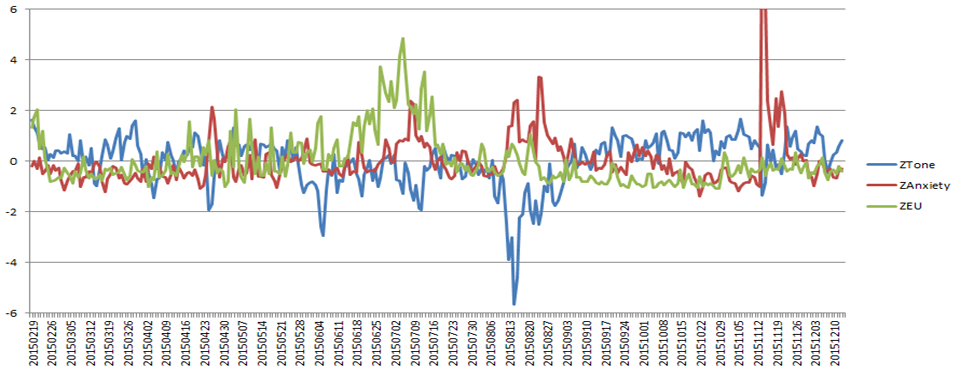
Economic stability and uncertainty plays a critical role in the overall stability and well-being of a nation. Scholars like Alexopoulos & Cohen and Baker, Bloom & Davis have constructed simple narrative indicators of economic uncertainty by looking for the keywords "economy/economic" and "uncertain/uncertainty" appearing together in articles from selected baskets of news outlets within a country and reporting them as a density over all coverage from those outlets in that country over time.
To explore what the output of these simple keyword-based measures might look like on GDELT, the complete February 19, 2015 to December 13, 2015 GDELT 2.0 archive of more than 177 million global news articles in 65 languages was scanned. To reduce false positives, articles were required to mention "economy" or "economic" at least twice anywhere in the article, compared to the single mention required in the traditional Alexopoulos & Cohen Economic Uncertainty (EU) measure. All articles mentioning "economy/economic" at least twice in the article and "uncertain/uncertainty" at least once in the same article were included in the EU measure.
For the Baker, Bloom & Davis Economic Policy Uncertainty (EPU) measure, the union keyword list of all of the country-specific Policy searches was used for the final Policy query, minus a handful of phrases that generated too high of a false positive rate. The final list of keywords used was "authorities, bank of japan, bank of korea, blue house, budget, central bank, congress, congressional, credit crunch, deficit, duma, federal reserve, fiscal policy, government, interest rate, interest rates, law, lawmakers, legislation, ministry of finance, monetary policy, national spending, people’s bank of china, policy, policymakers, political, public investment, public undertaking, reform, regulation, regulatory, spending, tax, white house, or world trade organization." For news coverage not originally in English, all searches were performed on the English human or machine translation of each article.
For the "By Source Country" measures, media was aggregated by estimated country of origin for each outlet and divided by the total volume of media monitored from outlets in that country in that day to yield a normalized country article density measure. This replicates the approach used in the original measures. For the "By Mentioned Country" measures, the number of articles mentioning each country in the world was tallied and divided by the total number of articles monitored globally in that day to yield a normalized global article density measure. Both normalization procedures are the recommended accepted normalization procedures for the GDELT GKG 2.0 dataset.
The final timelines below run February 19, 2015 to December 13, 2015 and are based on just over 177 million news articles sourced from nearly every country worldwide in 65 languages, with a special emphasis on local media. Note that they may differ from other compilations of the EU and EPU measures due to the vastly larger sample size and much deeper reach into local media, as well as potential error from source inclusion, article identification, and machine translation and the requirement that "economy/economic" appear twice in an article rather than only a single time.